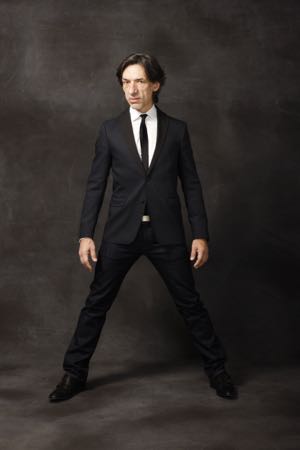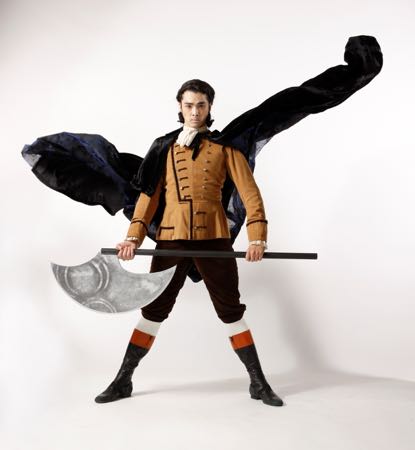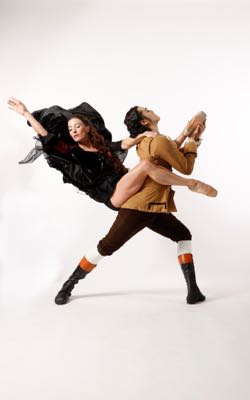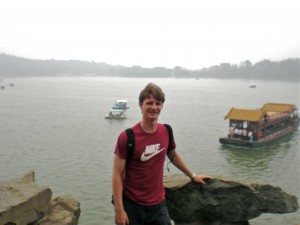
by Matt de la Peña
It’s a ghoulish Halloween morning in Chicago (winds reaching up to 50 mph, hail projected for the afternoon) and Septime Webre is talking America’s “first great ghost story.” The Washington Ballet artistic director, now in his 15th season at the helm of one of the country’s most versatile dance companies, is in the midst of his latest creation, an adaptation of Washington Irving’s spine-tingling classic, The Legend of Sleepy Hollow.
Webre has found a distinctive niche during his tenure at WB, a company he took over from the legendary Mary Day in 1999. His vision of The Nutcracker — set in 1882 Georgetown — has become a must-see event of the season. The Washington City Paper called his adaptation of Lewis Carroll’s Alice’s Adventures in Wonderland “an incredibly creative spectacle, pure and simple.” His adaptations of The Great Gatsby and The Sun Also Rises have proved to be ambitious ventures, offering a brand new vision of two American classics.
Webre and I spoke at length about Sleepy Hollow, his fascination with literature, and his plans for Halloween. Below are excerpts of our interview.
Can you tell me about Sleepy Hollow and how it came to be?
So about five years ago I launched a project called the American Experience. It’s a project to develop full-length ballets using great works of American literature. It seemed to me that our American story has not really been told in the ballet medium. [The Washington Ballet] started by adapting F. Scott Fitzgerald’s The Great Gatsby, then last year I adapted [Ernest] Hemingway’s The Sun Also Rises. Sleepy Hollow is the third installment about America’s first great ghost story.
That’s interesting you say that our American story has not been told; it seems odd that we, as Americans, wouldn’t take more interest in our own stories when it comes to ballet.
American ballet came into its ascendancy under Balanchine and the aesthetic has been abstract — a modernist aesthetic. So much of our stories are still stories written by old dead white guys. They’re so Eurocentric. The [American Experience] project is an effort to develop works in a different direction. It’s been fascinating to build these new ballets from scratch. In the case of the Hemingway and in the Gatsby projects, those works are so rich; it was a process of editing out information. In the case of Sleepy Hollow, it’s a thrilling, twenty-page short story. It’s very concise. The process has been the opposite; it’s been one of exuberance and extrapolation. It struck me early on that the headless horseman is haunting Ichabod Crane but one doesn’t know why. So I’ve developed Ichabod’s back-story. In a moment of anger, Ichabod picks up a sword and decapitates [a British soldier], essentially creating the Headless Horseman. The haunting is a Karmic guilt that Ichabod carries with him through his life. He moves to Sleepy Hollow to escape that torment.
Your fascination with 19th and 20th century literature is well known. You’ve created The Sun Also Rises, The Great Gatsby, and you’re in the midst of tackling Sleepy Hollow. What intrigues you about those particular time periods?

As a kid I discovered books. I grew up in the Bahamas until I was 12 on a tiny island. There was no television. There were really three things: I occupied my time with my brothers — I have eight brothers and a sister — and we were building sand castles like scale models of Versailles; putting on theatrical plays with my siblings, which led to some of my directorial interests; and a lot of time with books. Books seemed to sweep me into different time periods. I was always interested in history. Something about the energy and drive of Americans. The first part of the 20th century, American energy and ingenuity were at its height. The wheel starts to spin very quickly for we Americans. The whole hundred years since then has been a really fast trajectory of exuberant discovery. The 1920s have been fascinating to me because there were no rules; we were pioneers again, discovering our potential. Likewise, Sleepy Hollow takes place in the early years of the American Republic. There’s a kind of buoyant optimism about building a new country and starting fresh. That feels right to me. I suppose there’s also something to do with the fact that my family was Cuban refugees. I was the first son born outside of Cuba in the early ’60s, and so I grew up with the kind of fresh start. We feel a new fresh start in the first few years of the country, as in Sleepy Hollow.
In your mind how does a piece of literature qualify to become a dance?
I don’t think about the dance while reading the book, at least not initially. I’m just captured by the story and by elements of the writing style. So, for example, in the Hemingway project, I was super interested in Hemingway’s writing style. It’s a tough story to tell. When I realized that I could handle a ballet about erectile dysfunction, it meant I could handle any topic [laughs]. In the case of Hemingway I wanted to tell the story, but also reflect it in the dance vocabulary. Hemingway writes in this punchy, staccato, very masculine style. I consciously wanted to make movement phrases that were short, staccato, punchy, and similar to Hemingway. That was an interesting challenge.
Choosing Sleepy Hollow, I’ve been through a lot of things. Hemingway, which was my most recent project, was so very serious. I wanted something with a sense of fantasy. Hemingway was so black and white. I wanted something that was exciting, thrilling and theatrically extravagant. Sleepy Hollow fit that bill.
Do you find that stories with so much whimsy require a different approach to the techniques of classical ballet?
My experiments have been more on the classical side. I took over the company from the great Mary Day and Mary had a very particular point of view about the company. It was a small company doing a lot of neoclassical work, but other than The Nutcracker, she never presented a full-length classical ballet. Among the goals was to continue to forge new territory in terms of contemporary ballet. Over the last five years I’ve very carefully added full-length, 19th century works into the repertoire.
Right after Sleepy Hollow we’re staging a big production of Swan Lake. It doesn’t get more classical than that. The classical approach by our artists has grown. I want to challenge our dancers in a contemporary way, but also the classical way. I’m unafraid to work in the classical vernacular these days, whereas 15 years ago it was not my thing. I came from a classical background, but as a choreographer I was trying to develop my own voice.

I noticed on Facebook that you recently took part in a foggy evening photo shoot for Sleepy Hollow at the National Arboretum in Washington. It had a very cemetery-esque vibe. How was the experience?
Amazing. The visuals are stunning. There’s a really well known fashion photographer in D.C., Dean Alexander, and two art directors. Their team is called Design Army, and we’ve been working on a creative collaboration. If you go on Google you can see a photo shoot of ours of Alice in Wonderland. That was freaking amazing. It’s the same team that did that shoot and this year we’re adding a video component. It’s a whole multimedia experience. Fun to break outside the standard four walls of classical ballet mode.
I was impressed by how active you are on social media. I feel like most artistic directors would shy from that sort of thing, considering how prominently you figure in the public eye.
It’s funny. It’s shifted over time. I generally post stuff that’s fun and exciting to me. I was an early adopter [of Facebook] and it started with just my friends and family. It’s fun that over time it’s become what it’s become. So for sure try to keep current.
You’re using music by Matthew Pierce for Sleepy Hollow. How did you first learn about him?
I knew of his work because I knew he’d worked with Julia Adams and a few other choreographers: Julia at San Francisco Ballet, Stanton Welch from Houston Ballet, and David Palmer who used to be in Miami and is now with us at Washington Ballet. I love contemporary classical music for strings. It’s just my favorite sound. Actually Sleepy Hollow’s the third project I’ve worked with [Matthew] on. He did Alice in Wonderland and about three years ago, we did a project with Imagination Stage, DC’s preeminent equity children’s theater. We did a dance-theater fusion adaptation of The Lion, The Witch, and the Wardrobe. We have a really great relationship. As a matter of fact we’re in the throws of it right now. He literally was up last night at midnight sending me new music for the end of Act I. We’re just completing Act I and next week we start composing Act II together. He has a great intimate, emotional approach but also varied in texture. In Alice in Wonderland there’s crazy characters. He was able to, for Alice, create a sweet Gaelic hope tune for solo violin. The Cheshire cat was a crazy 1950s hot and sweaty jazz played in Harlem at four in the morning, but interpreted by a string quartet. Tweedle Dee and Tweedle Dum were modeled after the disco scene from Starsky and Hutch. Really a lot of wit folded into the music.
It’s October 31, so I have to ask: Any special plans for Halloween?
I will say I did get judged this morning when I ordered a Pumpkin Spice latte at Starbucks. [Laughs] I’m not kidding. I got so many snorts next to me. I’m going tonight, for Halloween, as a taxidermist. Jeans a work shirt, a buck knife and a deer head tucked underneath my arm.
That’s pretty much perfect.
It’s going to be fun.
The Washington Ballet’s Sleepy Hollow receives its world premiere February 18 – 22, 2015 at the Kennedy Center for the Performing Arts in Washington, D.C.

Contributor Matt de la Peña is the former dance editor at Time Out Chicago. While there he wrote about and interviewed numerous artists, including Robert Battle, Stephen Petronio, Trey McIntyre, Mats Ek, Andrea Miller, Miguel Gutierrez, Lar Lubovitch, Ashley Wheater, Glenn Edgerton and Alejandro Cerrudo, among others. His work has also appeared in the Chicago Tribune, ChicagoSide Sports and Dance International magazine.
Matt has a B.A. in journalism and communications with a minor in dance from the University of Iowa and an M.A. in writing and publishing from DePaul University. He is currently the digital communications manager at Carol Fox and Associates in Chicago.




